NPS Website; Local Website
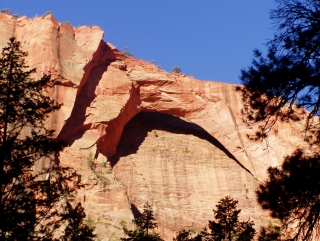 WHAT IS IT?
WHAT IS IT?229 square miles of beautiful scenery centered around the profound steep gorges shaped by the Virgin River and its tributaries with a little help from geological uplift.
BEAUTY (10/10)
Zion NP shares the same breathtaking landscape as its Colorado Plateau brethren: red rock arches, hoodoos, deep canyons, multicolored cliffs and striking buttes. What sets the Park apart is the Virgin River. The River fosters life as well as lush greens and blues, colors oft forgotten in these harsh environs.
HISTORICAL INTEREST (2/10)
Not much. In fact, it was one of the last areas in the continental United States to be fully surveyed. Piute Indians lived in the oasis for over 10,000 years but their lives and place names have been literally removed from the Site. When the Park was named a National Monument in 1909, it was known by the Piute name, Mukuntuweap. Ten years later, the area became a National Park and was renamed, Zion.
Mormons began settling in the area in the late 19th Century. They named the place Zion, what the Park brochure refers to as a biblical reference to a place of refuge but we believe has a much stronger connotation. The Mormons also designated most of the landforms with religious names: Cathedral Mountain, Mount Moroni, the Great White Throne, the Court of the Patriarchs and Angel’s Landing. However, the Virgin River’s naming actually predates the Mormon settlers.
The place names are of little historical interest but they did affect our visit. An air of piety, especially that of the Mormon faith, hangs over the natural cliffs and wonders of the Park. We did not see sparkling white cathedrals, Old Testament judges or Latter Day Saints and the subtle imposition of a theology was not what we were looking for at a National Park.
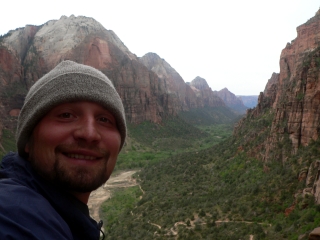 CROWDS (8/10)
CROWDS (8/10)Near the end of the Virgin River Narrows Hike, a recent Brown alum spotted Gab’s hat and shook her hand. This is the first time on the trip anyone has recognized and accurately placed the “B” on Gab’s head. Most mistake her for a Boston Red Sox fan. She was overjoyed by her scholastic compatriot. Evident by her jumping up and down while standing knee deep in 50-degree water and by her rapid-fire recital of Brown University fight songs, cheers and mottos. Who knew she had such school spirit?
EASE OF USE/ACCESS (5/5)
Zion NP is one of the easier wilderness National Parks to get to. It is 30 miles east of Interstate 15 in southwestern Utah and 150 miles east of Las Vegas, Nevada.
The Park’s main attraction is the Canyon of the Virgin River with both its mesmerizing narrow walls and acrophobia-inducing rim ledges. The Park allows the visitor inside its canyon’s walls. The views are not from above, like at the Grand Canyon, the Black Canyon of the Gunnison or Bighorn Canyon. You do not have to hike thousands of feet downhill to see greater wonders; you just have to jump on a free shuttle bus.
Easy access brings more people and the shuttle buses do a terrific job of dealing with the crowds. From April through October, cars are not allowed on the Zion Canyon Road. Insufficient parking and the slender two-lane road combined with millions of visitors created the shuttles’ necessity.
There are two shuttle loops, one leaves the Visitor Center every ten minutes and travels northward to the Temple of Sinawava. If you want to follow the River any further, you need to walk through the water. Along the way, the shuttle stops at a number of overlooks/trailheads. It is a great way to travel.
The second shuttle loop runs from the Visitor Center southward into the town of Springdale and stops wherever you might be lodging or dining. In the summer, both shuttles run from 5:45am to 11:15pm; in the spring and fall from 6:45am to 10:15pm. More than enough time for spectacular sunrises, early morning hikes and late nights out in Utah.
CONCESSIONS/BOOKSTORE (5/5)
The Bookstore at Zion spans the entire width of the Visitor Center. In addition to the rows and rows of books arranged by subject, there is an entire wall of framed prints of Zion’s most famous landmarks photographed at sunrise, sunset and various points in the day. Zion offers a small selection of the retro-WPA National Parks posters that we adore as well as the usual selection of shirts, totes, and souvenirs. Volume and selection earn Zion a high mark.
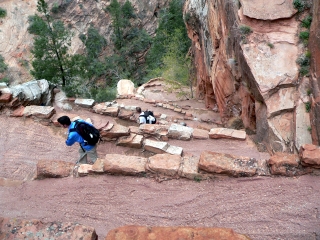 COSTS (2/5)
COSTS (2/5)Entrance is $20 per car or $10 per person if you walk in. There is a $20 maximum per family. The Park is free with the National Parks Pass.
Camping is not cheap. Most of the 160-site Watchman Campground costs $16 per night; a riverside site goes for $20. Reservations are taken from April to November. The 126-site South Campground costs $16 per night and operates on a first-come first-served basis.
We preferred the look of the Watchman Campground, because it had tent-only sections and because of its proximity to the Visitor Center and the Shuttle Bus Stations, and decided to stay there. We did not have a reservation and were lucky to get a site even though it was a late September Sunday. The Campground was full during our entire stay. If you are going in summer, good luck.
The excellent Zion Canyon shuttle bus is always free.
Xanterra operates the historic Zion Lodge inside the Park. It had no vacancy, as did nearly all of nearby Springdale’s motels.
RANGER/GUIDE TO TOURIST RATIO (2/5)
God bless any Ranger working at the Kolob Canyon Visitor Center. That VC is in the Park’s northwestern most corner, a few hundred yards from Interstate 15, Exit 40. Hundreds, if not thousands of visitors, every day, must see the brown NPS sign reading “Zion National Park, This Exit”. Technically true, but over an hour from the more famous Zion Canyon parts of the Park.
We wanted a Kolob Canyon backcountry permit so we could hike to the Kolob Arch, the largest free-standing arch in the world. We had to get it at that Visitor Center. During our request, tourist after tourist bogged down our poor Ranger with the same questions: “Where is the real part of the Park?”, “How do I get there?”, “Can I do it all in a few hours” and “Can I pay here?” Of course, they had to pay there and without a fee station the Ranger had his hands full. Between answering questions and printing receipts, he spent at least a half hour typing in our backcountry request form.
The situation at Zion Canyon Visitor Center is not much better. An outdoor museum filters most people away from the Rangers, but there still are not nearly enough people to answer questions. We waited in line to inquire about the Virgin River Narrows Hike. When the Ranger directed us to the Backcountry Station, we found no one on duty. We ended up getting our hiking information not from a Ranger or from an NPS publication but from a helpful Hiking Zion brochure we picked up at a local outfitter.
The campgrounds are full and the area motels are full. Why is there not enough funding for a full Ranger staff? Late-September enjoys only six Ranger-led programs and the 9am “Ride With a Ranger Shuttle Tour” is so popular that tickets are very hard to come by. Our shuttle bus driver did his best to explain the area topography and history but his explanations were dubious, a pale comparison to what a Ranger could tell. It is sad that the Shuttle Bus Drivers’ words and experiences with Zion constitute the average learning visit to the Park and that little can be done to counter the lack of Ranger encounters.
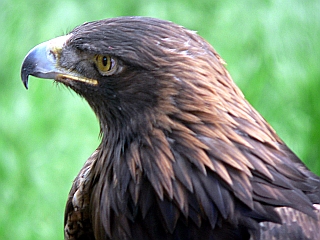 TOURS/CLASSES (6/10)
TOURS/CLASSES (6/10)Unlike most parks we have visited, the Visitors Center is not the hub of learning at Zion. Ranger talks and walks leave from a variety of points like the Campgrounds and Zion Lodge. There is no Welcome to Zion film – unless you want to shell out $10 for the privately owned IMAX just outside of the park’s entrance. The Visitor Center serves as pick-up and drop off point for the park shuttle, registration for backcountry camping (allegedly. There were no Rangers available when we went), space for the impressive bookstore and neighbor to large bathrooms with the only accessible electrical outlets in the park.
If you are searching information about Zion’s history, free standing displays outside of the Visitor Center will give you a good introduction. We hadn’t actually seen this set up before – with so much information available 24/7, not dependent upon the hours of the VC. We kinda like it. Of course, there are some drawbacks: you have to stand to read the vertical panels. Even though the panels are printed on both sides, crowds will impede your ability to view them, If you do have any questions, the closest Rangers are presumably inside the VC, if it’s open.
The new Zion Museum, opened in 2002, houses artifacts and displays specific to human history in the Zion area. This is where you’ll find the NPS slide program about Zion – the kind that makes you envious of the filmmaker’s high-quality camera and ability to take those shots that you see in your mind, but can’t quite seem to capture on your trusty digital cam. Oh, maybe that’s just us.
The Museum is a short drive from the VC. It can also be reached via a leisurely stroll on the paved Pa’rus Trail. Michael was drawn to the contrasting quotes of Brigham Young, Mormon leader who was eager to draw from the land’s resources, and Paiute Indian Chiefs, who were seeing their lands and ways of life destroyed through the rapid removal of timber and native plants. Gab spent her time in front of a temporary exhibit in the other room which consisted simply of pictures and oral histories collected from present day members of the Paiute and other Indian tribes. The museum is small, but nicely done. Try not to miss it.
FUN (10/10)
We jumped into Zion’s backcountry headfirst. We drove to Zion from the north and feared that if we didn’t see the Kolob region first, we would never get to it. Even though we hadn’t been planning to camp that night, a permit was available and the afternoon sun was beginning to fade. There was no excuse not to make the 7.5 mile hike into the Kolob Canyon. When the Ranger told us that the best time of day to see the Kolob Arch – possibly the largest natural freestanding arch in the world – was at sunrise, our decision was made.
That night, we enjoyed one of the nicest campsites of the trip. Nestled in a shaded area just steps away from a fresh spring, canyon wall high and blazing red on either side. We saw no one. We left camp early morning in search of the Arch and were soon glad that we left our packs behind. The hike is a scramble through streams and over rocks – it was refreshing and fun. This is the Zion we tried to remember as we entered the much more populated southern section.
Just as crowds and the smoke from the scheduled forest burn (which began the day we arrived) was getting us down, we discovered the shuttle and the Narrows. For days we debated which hikes to take here. We were discouraged from the Narrows – the water temp was a chilly 50 degrees and photos at the VC showed people with full packs (and wet suits!) slogging through muddy water. No thanks. We’ll have a stroll on the Riverwalk up to the entrance of the Narrows and see what pictures we can gather from there.
It didn’t work out that way. The end of the Riverwalk and entrance of the Narrows was filled with people having the same discussion as us – should we? The morning sun was streaming in, making the water look more inviting than it should have. Some brave souls grabbed walking sticks and splashed in. That’s all it took. Gab was ankle-deep before Michael could even protest. The next five hours were spent in this wonderful, wet playground.
If you come to Zion NP, take the Narrows hike. Did we mention that there is no path along the riverbanks? The trail is the Virgin River itself. The rocks can be slippery and the current swift but it is so worth it. Outfitters in Springdale rent boots and socks made to handle the hike up the Canyon. We tackled the hike in our trusty waterproof Keen sandals. Our shoe selection is not recommended, Michael was paranoid about twisted ankles the whole time, but doable.
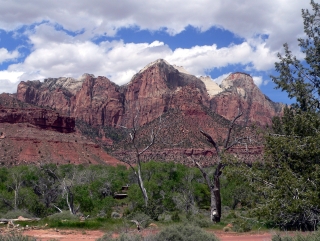 WOULD WE RECOMMEND? (10/10)
WOULD WE RECOMMEND? (10/10)When people talk about America’s National Parks, Zion is often mentioned by name. It is part of the Southwest’s “Grand Circle” of parks, historical sites and recreational areas – easy to get to with a lot to offer its visitors.
Avid hikers and armchair enthusiasts can all get a glimpse of Zion – the shuttle service and gateway town of Springdale makes the park accessible to those with physical restrictions and to those who would rather not do without creature comforts. Gab’s a great fireside cook, but we snuck away for more than one snack in town. Restaurants are plentiful and not as expensive as they could be considering their location.
Those who want to escape the crowds can try for backcountry permits or just spend the day tackling some of the more strenuous hikes – there are more than a few to choose. Angels Landing and Observation Point are two of the most popular, and most steep trails, each boasting significant switchbacks and promising spectacular views. But don’t worry, if you prefer your walk to be more horizontal, trails alongside Emerald Pools and Weeping Rocks will keep you entertained.
TOTAL 60/80
www.usa-c2c.com
© 2004-06